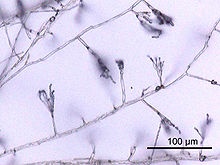Hypha




A hypha (from
Structure
A hypha consists of one or more cells surrounded by a tubular cell wall. In most fungi, hyphae are divided into cells by internal cross-walls called "septa" (singular septum). Septa are usually perforated by pores large enough for ribosomes, mitochondria, and sometimes nuclei to flow between cells. The major structural polymer in fungal cell walls is typically chitin, in contrast to plants and oomycetes that have cellulosic cell walls. Some fungi have aseptate hyphae, meaning their hyphae are not partitioned by septa.
Hyphae have an average diameter of 4–6
Growth
Hyphae grow at their tips. During tip growth, cell walls are extended by the external assembly and
As a hypha extends, septa may be formed behind the growing tip to partition each hypha into individual cells. Hyphae can branch through the bifurcation of a growing tip, or by the emergence of a new tip from an established hypha.
Behavior
The direction of hyphal growth can be controlled by environmental stimuli, such as the application of an electric field. Hyphae can also sense reproductive units from some distance, and grow towards them. Hyphae can weave through a permeable surface to penetrate it.[3]
Modifications
Hyphae may be modified in many different ways to serve specific functions. Some
Types
Classification based on cell division
- Septate (with septa)
- Aspergillus[8] and many other species have septate hyphae.
- Aseptate (non-septate) or coenocytic (without septa)
- Non-septate hyphae are associated with Mucor,[9] some zygomycetes, and other fungi.
- Pseudohyphae are distinguished from true hyphae by their method of growth, relative frailty and lack of cytoplasmic connection between the cells.
Classification based on cell wall and overall form
Characteristics of hyphae can be important in fungal classification. In
- Generative hyphae are relatively undifferentiated and can develop reproductive structures. They are typically thin-walled, occasionally developing slightly thickened walls, usually have frequent septa, and may or may not have clamp connections. They may be embedded in mucilage or gelatinized materials.
- Skeletal hyphae are of two basic types. The classical form is thick-walled and very long in comparison to the frequently septate generative hyphae, which are unbranched or rarely branched, with little cell content. They have few septa and lack clamp connections. Fusiform skeletal hyphae are the second form of skeletal hyphae. Unlike typical skeletal hyphae these are swollen centrally and often exceedingly broad, hence giving the hypha a fusiform shape.
- Binding hyphae are thick-walled and frequent branched. Often they resemble deer antlers or defoliated trees because of the many tapering branches.
Based on the generative, skeletal and binding hyphal types, in 1932 E. J. H. Corner applied the terms monomitic, dimitic, and trimitic to hyphal systems, in order to improve the classification of polypores.[13][14]
- Every fungus must contain generative hyphae. A fungus which only contains this type, as do fleshy mushrooms such as agarics, is referred to as monomitic.
- If a fungus contains the obligate generative hyphae (as mentioned in the last point, "every fungus must contain generative hyphae") and just one of the other two types (either skeletal or binding hyphae), it is called dimitic. In fact dimitic fungi almost always contain generative and skeletal hyphae; there is one exceptional genus, Laetiporus that includes only generative and binding hyphae.
- Skeletal and binding hyphae give leathery and woody fungi such as polypores their tough consistency. If a fungus contains all three types (example: Trametes), it is called trimitic.
Fungi that form fusiform skeletal hyphae bound by generative hyphae are said to have sarcodimitic hyphal systems. A few fungi form fusiform skeletal hyphae, generative hyphae, and binding hyphae, and these are said to have sarcotrimitic hyphal systems. These terms were introduced as a later refinement by E. J. H. Corner in 1966.[15]
Classification based on refractive appearance
Hyphae are described as "gloeoplerous" ("gloeohyphae") if their high refractive index gives them an oily or granular appearance under the microscope. These cells may be yellowish or clear (
Classification based on growth location
Hyphae might be categorized as 'vegetative' or 'aerial.' Aerial hyphae of fungi produce asexual reproductive spores.[18]
See also
- Ascocarp – Fruiting body of an ascomycete fungus.
- Hartig net – Network of inward-growing hyphae
- Mycorrhizal network – Underground fungal networks that connect individual plants together
References
- ISBN 0-13-144329-1.
- ISBN 978-1-4398-3904-1.
- ^ .
- PMID 22136757.
- S2CID 15134716.
- PMID 17259546.
- ISBN 978-0521186957
- ^ "Mycology Online – Aspergillosis". Archived from the original on 2008-12-07. Retrieved 2008-12-10.
- ^ Klatt, Edward C. "Mucormycosis". WebPath. University of Utah School of Medicine. Retrieved 10 December 2008.
- ^ Reiss, Errol; DiSalvo, Art (31 May 2018). "Yeasts". In Hunt, Richard (ed.). Microbiology and Immunology On-line. University of South Carolina. Retrieved 20 November 2020.
- PMID 15223059.
- ^ "Hyphal System". Illinois Mycological Association. Archived from the original on 2006-10-14. Retrieved 2007-02-11.
- .
- ^ Cunningham GH (1954–55). "Taxonomic Problems of some Hymenomycetes". Transactions and Proceedings of the Royal Society of New Zealand. 82: 893–6.
- ^ Corner EJH (1966). "Monograph of cantharelloid fungi". Ann. Bot. Mem. 2: 1–255.
- ISBN 0-9508486-0-3.
- ^ See section "Microscopic features ..." of 2006 Summer Workshop in Fungal Biology for High School Teachers Archived 2008-06-25 at the Wayback Machine, Hibbett lab, Biology Department, Clark University, "Guidelines for collecting and identifying macrofungi (basidiomycetes)".
- ^ Kaiser, Gary E. (2014-06-01). "II: FUNGI". Retrieved 2020-03-10.
External links
- Close-up light micrograph of coenocytic hyphae
- MicrobiologyBytes: Introduction to Mycology
- Hyphal growth and branching movies by P.C. Hickey and N. Read, University of Edinburgh
- Fungi Online Fungi Online: An Introduction to the Biology of Fungi
